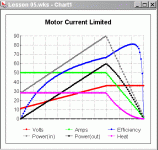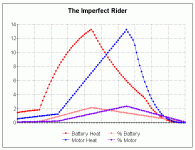safe said:eP said:So what you want get after you apply your 50A blind controller ?
20 minutes typical ride time ?
and 10 mile typical range ?
A slightly higher top speed.
Slower from 0-10 mph.
Less heat compared to an "Imperfect Rider" and standard controller.
Range should be about the same.
In which way ?
At 50A load you get 156% heat and lower motor efficiency.
At higher speed you get square higher air drag so your Wh/mile must rise !!
How much you are Imperfect now ?





